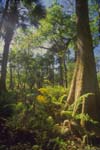Tropical Deforestation & Habitat Destruction
 Habitat loss takes several forms: outright loss of
areas used by wild species; degradation, for example, from vegetation removal and erosion,
which deprive native species of food, shelter, and breeding areas; and fragmentation, when
native species are squeezed onto small patches of undisturbed land surrounded by areas
cleared for agriculture and other purposes. In the latter case, ecosystem functions such
as the hydrological cycle might be interrupted, native species may be crowded out because
habitat fragments are too small, and fragment edges may prove uninhabitable to plants and
animals associated with the habitat type because of exposure to wind, sunlight, new
predators, and other factors (referred to by ecologists as edge effect). Photo: PhotoDisc Inc.
Habitat loss takes several forms: outright loss of
areas used by wild species; degradation, for example, from vegetation removal and erosion,
which deprive native species of food, shelter, and breeding areas; and fragmentation, when
native species are squeezed onto small patches of undisturbed land surrounded by areas
cleared for agriculture and other purposes. In the latter case, ecosystem functions such
as the hydrological cycle might be interrupted, native species may be crowded out because
habitat fragments are too small, and fragment edges may prove uninhabitable to plants and
animals associated with the habitat type because of exposure to wind, sunlight, new
predators, and other factors (referred to by ecologists as edge effect). Photo: PhotoDisc Inc.
While much attention has been paid to deforestation and other forms of habitat
destruction, few attempts have been made to measure the loss of habitat through
fragmentation and edge effect. A 1993 study of deforestation and fragmentation in the
Brazilian Amazon basin between 1978 and 1988 found that of total habitat affected, only 39
percent could be attributed to outright forest conversion; the rest occurred through
fragmentation and edge effect. (United
Nations Development Program, 1994).






